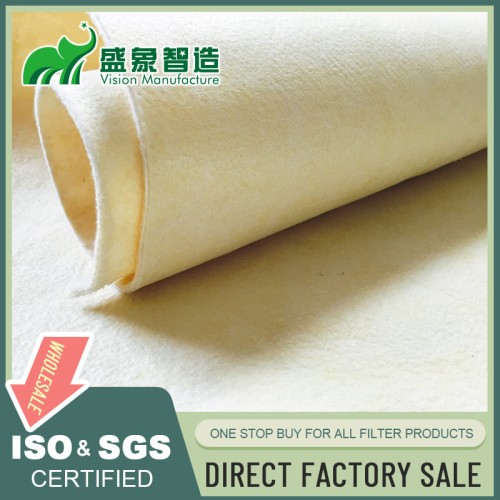
Fiberglass Felt: Versatile High-Temperature Filtration Solution
I. Introduction
Fiberglass felt is a pivotal material in high-temperature industrial filtration, offering unique properties that make it indispensable in environments where conventional materials fail. This article explores the characteristics of fiberglass as a filtration medium, its advantages, and its critical role in demanding industrial processes.
Fiberglass felt is a pivotal material in high-temperature industrial filtration, offering unique properties that make it indispensable in environments where conventional materials fail. This article explores the characteristics of fiberglass as a filtration medium, its advantages, and its critical role in demanding industrial processes.
II. Properties of Fiberglass Felt
- Temperature Resistance: Capable of withstanding extremely high temperatures, making it ideal for hot gas applications.
- Chemical Inertness: Resists chemical degradation, ensuring longevity and consistent performance in corrosive environments.
- Dimensional Stability: Maintains its shape and size under thermal stress and mechanical forces.
- Excellent Filtration Efficiency: Effectively captures fine particulates, even under strenuous conditions.
- Durability and Strength: Offers significant resistance to wear and tear, prolonging the operational lifespan.
III. Manufacturing Process
- Fiberglass Production: Involves the creation of glass fibers through a melting and extrusion process.
- Felt Formation Techniques: Fibers are laid into a mat and then bonded, typically through needling or thermal processes.
- Needling and Thermal Bonding: Enhance the mechanical integrity and filtration properties of the felt.
- Finishing Treatments: Surface treatments are applied to improve filtration efficiency and dust cake release.
IV. Types of Fiberglass Felt
- Needled Fiberglass Felt: Provides excellent depth filtration and mechanical stability.
- Thermally Bonded Fiberglass Felt: Offers superior dimensional stability and resistance to shedding.
- Resin-Treated Fiberglass Felt: Enhances chemical resistance and filtration performance.
- Composite Fiberglass Felts: Combine fiberglass with other materials to meet specific filtration needs.
V. Applications in Industrial Filtration
Fiberglass felt is used in:
Fiberglass felt is used in:
- Hot Gas Filtration: Ideal for capturing particulates in high-temperature exhaust streams.
- High-Temperature Liquid Filtration: Filters hot liquids in industrial processes without degrading.
- Cement and Lime Kilns: Captures particulates and withstands the harsh conditions of cement production.
- Steel and Metal Processing: Used in filtration systems where high temperatures are common.
- Power Generation Plants: Filters flue gases in coal-fired and gas turbine power plants.
- Waste Incineration Facilities: Efficiently removes ash and particulate matter from incineration processes.
VI. Performance Characteristics
- Filtration Efficiency at High Temperatures: Maintains high performance even under extreme heat.
- Dust Cake Formation and Release: Facilitates easy cleaning due to its non-stick surface properties.
- Pressure Drop Profiles: Designed to minimize pressure drops, enhancing system efficiency.
- Chemical Resistance in Various Environments: Performs reliably in both acidic and basic environments.
VII. Design Considerations
- Felt Thickness and Density: Customizable to enhance filtration efficiency and operational life.
- Surface Treatments and Finishes: Can include coatings to improve dust release and resistance to blinding.
- Integration with Support Structures: Ensures compatibility with existing filtration systems and housings.
- Customization for Specific Applications: Tailored solutions to meet unique operational demands.
VIII. Installation and Maintenance
- Proper Handling and Safety Precautions: Essential to maintain the integrity of the material during installation.
- Installation Techniques: Must be performed correctly to ensure optimal fit and function.
- Cleaning and Regeneration Methods: Includes techniques suitable for high-temperature operations.
- Monitoring and Replacement Guidelines: Regular checks help maintain performance and prevent system failures.
IX. Advantages Over Other High-Temperature Materials
- Cost-effectiveness Compared to Exotic Materials: Offers a more affordable solution without compromising on performance.
- Excellent Balance of Filtration and Durability: Provides a reliable filtration solution that withstands harsh conditions.
- Availability and Ease of Fabrication: Widely available and easy to manufacture into various forms.
- Consistent Performance Over Time: Delivers reliable results throughout its service life.
X. Environmental and Safety Considerations
- Emissions Control Capabilities: Effectively reduces particulate emissions, aiding in environmental compliance.
- Workplace Safety in High-Temperature Environments: Enhances safety by reducing exposure to harmful particulates.
- Disposal and Recycling Practices: Encourages responsible end-of-life handling to minimize environmental impact.
- Regulatory Compliance Aspects: Meets stringent industry standards for emissions and safety.
XI. Innovations and Future Trends
- Advanced Fiber Formulations: New developments in fiber technology enhance heat resistance and filtration efficiency.
- Hybrid Felts with Enhanced Properties: Combines fiberglass with other materials for superior performance.
- Smart Monitoring Integration: Incorporates sensors to provide real-time data on filter condition and performance.
- Sustainable Manufacturing Practices: Focuses on reducing environmental impact during production and disposal.
XII. Cost-Benefit Analysis
- Initial Investment Considerations: Evaluates the upfront costs against the long-term benefits of using fiberglass felt.
- Long-term Operational Savings: Highlights savings from reduced maintenance and extended service intervals.
- Energy Efficiency Improvements: Fiberglass felt's efficiency can lead to lower energy consumption in filtration systems.
- Reduced Maintenance and Downtime Costs: Durable properties lead to fewer replacements and less downtime.
XIII. Case Studies and Success Stories
Examples from various industries demonstrate how fiberglass felt has solved complex filtration challenges, improved process efficiency, and enhanced compliance with environmental regulations.
Examples from various industries demonstrate how fiberglass felt has solved complex filtration challenges, improved process efficiency, and enhanced compliance with environmental regulations.
XIV. Conclusion
Fiberglass felt is a high-performance filtration material suited for extreme conditions, offering durability, efficiency, and adaptability across a range of industrial applications. As technology advances, it continues to play a crucial role in meeting the evolving needs of modern industries.
Fiberglass felt is a high-performance filtration material suited for extreme conditions, offering durability, efficiency, and adaptability across a range of industrial applications. As technology advances, it continues to play a crucial role in meeting the evolving needs of modern industries.
Leave a comment

